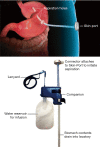Endoscopic bariatrics: current therapies and future directions
- PMID: 35548475
- PMCID: PMC9081914
- DOI: 10.21037/tgh.2020.03.09
Endoscopic bariatrics: current therapies and future directions
Abstract
Endoscopic bariatric therapies (EBTs) are endoscopic procedures indicated for weight loss in the obese population. They are shown to be safe and effective for patients who do not quality for bariatric surgery. There are currently no randomized controlled studies comparing bariatric surgery with EBTs. However, EBTs are more cost effective and have fewer complications. This review will examine currently available EBTs with published data.
Keywords: Bariatric; aspiration; duodenal mucosal resurfacing; duodenal-jejunal bypass liner; endobariatric; endobarrier; endoscopic sleeve gastroplasty; endoscopy; gastro-duodeno-jejunal bypass sleeve; intragastric balloon (IGB); obesity; primary obesity surgery endoluminal (POSE); transoral outlet reduction (TORe); transpyloric shuttle (TPS).
2022 Translational Gastroenterology and Hepatology. All rights reserved.
Conflict of interest statement
Conflicts of Interest: All authors have completed the ICMJE uniform disclosure form (available at https://tgh.amegroups.com/article/view/10.21037/tgh.2020.03.09/coif). The series “Innovation in Endoscopy” was commissioned by the editorial office without any funding or sponsorship. AS reports personal fees from Obalon, outside the submitted work. The authors have no other conflicts of interest to declare.
Figures







Similar articles
-
Endobariatrics: a Still Underutilized Weight Loss Tool.Curr Treat Options Gastroenterol. 2023;21(2):172-184. doi: 10.1007/s11938-023-00420-6. Epub 2023 May 6. Curr Treat Options Gastroenterol. 2023. PMID: 37284352 Free PMC article. Review.
-
Endoscopic therapy for weight loss: Gastroplasty, duodenal sleeves, intragastric balloons, and aspiration.World J Gastrointest Endosc. 2015 Jul 25;7(9):847-59. doi: 10.4253/wjge.v7.i9.847. World J Gastrointest Endosc. 2015. PMID: 26240686 Free PMC article. Review.
-
Current State of Endoscopic Bariatric Therapies.Surg Clin North Am. 2025 Feb;105(1):159-171. doi: 10.1016/j.suc.2024.06.012. Epub 2024 Aug 1. Surg Clin North Am. 2025. PMID: 39523071 Review.
-
Do Endoscopic Bariatric Procedures Improve Postprocedural Quality of Life and Mental Health? A Systematic Review and Meta-analysis.Obes Surg. 2020 Oct;30(10):4091-4100. doi: 10.1007/s11695-020-04860-2. Epub 2020 Aug 6. Obes Surg. 2020. PMID: 32761319
-
Endoscopic Bariatric Therapies: Intragastric Balloons, Tissue Apposition, and Aspiration Therapy.Curr Treat Options Gastroenterol. 2019 Jun;17(2):187-201. doi: 10.1007/s11938-019-00232-7. Curr Treat Options Gastroenterol. 2019. PMID: 30963378 Review.
Cited by
-
Phenotyping of Obesity Treatment Candidates: A Narrative Review.Curr Obes Rep. 2024 Sep;13(3):564-573. doi: 10.1007/s13679-024-00576-x. Epub 2024 Jun 14. Curr Obes Rep. 2024. PMID: 38874701 Review.
-
Nutritional Challenges and Treatment After Bariatric Surgery.Annu Rev Nutr. 2024 Aug;44(1):289-312. doi: 10.1146/annurev-nutr-061121-101547. Epub 2024 Aug 12. Annu Rev Nutr. 2024. PMID: 38768613 Free PMC article. Review.
-
Efficacy of Intragastric Balloon Treatment: Outcomes and Patient Satisfaction 6 Months After Removal.Medicina (Kaunas). 2025 Mar 28;61(4):616. doi: 10.3390/medicina61040616. Medicina (Kaunas). 2025. PMID: 40282907 Free PMC article.
-
Impact of Bariatric Surgery and Endoscopic Therapies on Liver Health in Metabolic Dysfunction-Associated Steatotic Liver Disease: A Review.J Clin Med. 2025 Jun 6;14(12):4012. doi: 10.3390/jcm14124012. J Clin Med. 2025. PMID: 40565758 Free PMC article. Review.
-
Endoscopic Sleeve Gastroplasty: a Proposal for a Minimal Invasive Endoscopic Approach to Adolescent Obesity.Obes Surg. 2025 Aug 13. doi: 10.1007/s11695-025-08139-2. Online ahead of print. Obes Surg. 2025. PMID: 40796997 Review.
References
Publication types
LinkOut - more resources
Full Text Sources
